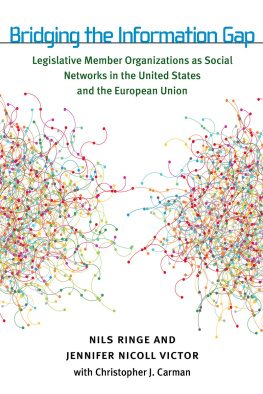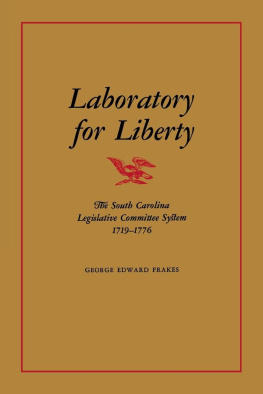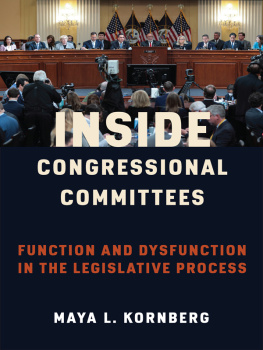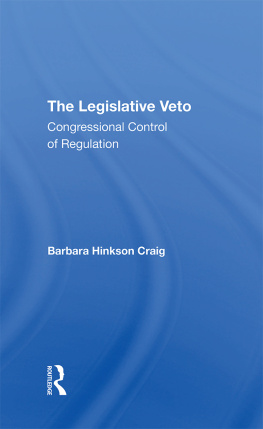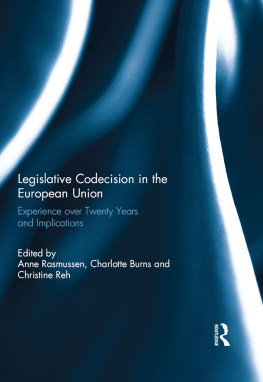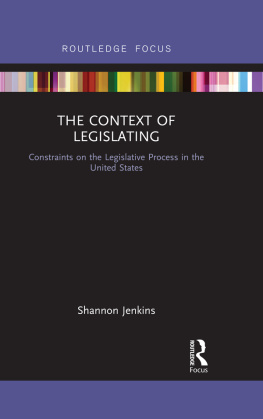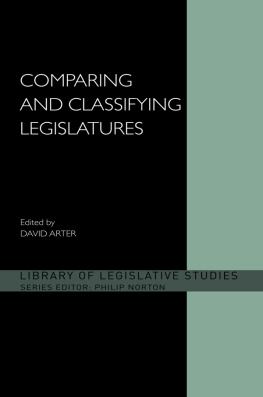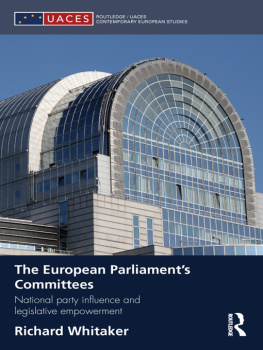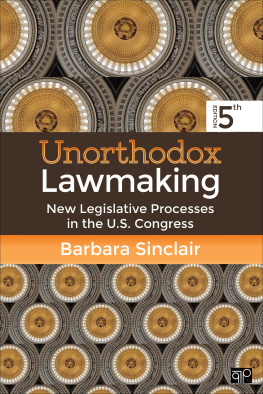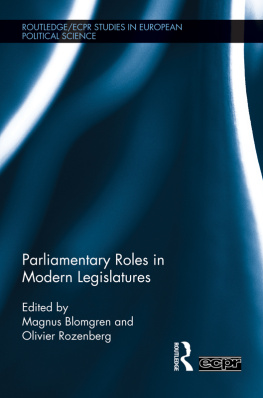ACKNOWLEDGMENTS
The idea for this book grew out of our mutual interest in social networks in legislative politics and legislative member organizations (LMOs) as often-overlooked features of the institutional structure of many lawmaking bodies. What started out as an idea for a comparative paper on LMOs quickly became a much greater undertaking, largely as a consequence of the relative dearth of previous research on LMOs. With greater ambition came the need for more data, a greater variety of methodological tools, and careful theorizing. In the process of writing this book, we have become indebted to a great many people.
Our sincerest thanks go to all of our respondents in the European Parliament and the U.S. Congress, without whom none of this research would have been possible. We are also grateful to all respondents to our expert survey, who provided the data used in the analysis in .
Christopher Carman made contributions to this project primarily in its formative stages by helping to conceptualize theory and research design. In addition, he conducted interviews in Brussels and Washington, D.C.; helped to code the qualitative data; and engaged in intercoder reliability checks. He also contributed to the quantitative analyses in ) and provided comments on parts of the chapter drafts.
We are grateful for the support this project has received from the European Union Center of Excellence at the University of Wisconsin, the European Union Center of Excellence at the University of Pittsburgh, the Steven D. Manners Faculty Development Award via the University Center for Social and Urban Research at the University of Pittsburgh, and the Central Research Development Fund via the Office of Research at the University of Pittsburgh.
We thank all participants in a book manuscript workshop held at the University of Pittsburgh on February 25, 2011. We are particularly indebted to our discussants, Marie Hojnacki, John Carey, and John Scholz, who provided invaluable insights and suggestions. We are also grateful to KarenLautanen, who helped to organize the conference. We greatly appreciate the input we received from the participants in the Comparative Politics Colloquium in the Political Science Department at the University of WisconsinMadison on April 21, 2010, and the Comparative Politics Workshop at Yale University on November 30, 2010.
We offer particular thanks to Barry Ames, Sanja Badanjak, David Canon, Skyler Cranmer, Logan Dancey, Christine Degregorio, James Fowler, Scott Gehlbach, Elisabeth Gerber, Justin Gross, Sarah Halpern-Meekin, Kyle Hanniman, Michael Heaney, Yoi Herrera, Jonathan Hurwitz, David Judge, Michael Kaeding, Kristin Kanthak, Justin Kirkland, David Lazer, Christine Mahoney, Melanie Manion, Scott Morgenstern, and Hans Noel for substantive comments and suggestions that have greatly improved this final product. We also thank Mary Stafsholt for her help with our network figures in .
We have relied on a number of research assistants throughout the data collection process and thank them for their diligence and hard work. At the University of Wisconsin, we are grateful to Sharmila Gosh, Katrina Helmer, Jordan Kook, Luke Petrovich, and Maysen Yen. At the University of Pittsburgh, we thank Kristen Coopie Allen, Anthony Brino, Ian Cook, Samuel Covert, Patrick Dalsass, Daniel Gore, Zach Gozlan, Bruno Heopers, Matthew Higgins, Benjamin Melusky, Brandon Myers, Dillon Narry, Emily Ordway, Suzanna Ploszaj, and Marika Stettner. We also thank Conrad Nicoll for collecting the caucus membership data for the 103rd Congress and Justin Kirkland for supplying cosponsorship data and advice about analysis.
Senthil Natarajan at the University of Pittsburgh assisted us in operating the PittGrid virtual supercomputer and advised us about programming.
Furthermore, we are grateful to Donald Musa, David Halpern, and the staff at the Qualitative Data Analysis Program (QDAP) at the University Center for Social and Urban Research at the University of Pittsburgh who transcribed our interviews.
For help with our expert survey and information on LMOs in particular national legislatures we thank Aslaug Asgeirsdottir, Sanja Badanjak, Hannah Britton, Mark Di Virgilio, Katja Favretto, Ulrich Hschen, Jason Koepke, Kostas Kourtikakis, Lisa London, Ewa Mahr, Tricia Olsen, Marios A. Panayides, Michael Schatzberg, Evaldas Sinkevicius, Margit Tavits, Aili Tripp, Kristin Vekasi, and Emilia Zankina.
We are also grateful to Lyndsay Monaco, who provided Jennifer with much-needed assistance on the home front that allowed her to spend so much time working on this project.
We appreciate the support and important substantive input from two anonymous reviewers. We also thank a number of staff at the University of Michigan Press, especially Melody Herr, who has simply been tremendous as our editor.
Last but certainly not least, we thank our spouses, Sarah Halpern-Meekin and Robert Victor, without whose understanding, support, and creative ideas this project would not have been possible. We also are grateful to Julia Victor, Adam Victor, and Scrappy for their unconditional love and support.
APPENDIX A
Our survey was administered between February 10, 2010, and February 5, 2011.
Survey Questions
Round 1: Initial questions.
1. Do LMOs exist in the national legislature of [country]?
2. If yes, what are they called?
3. Can you provide advice, citations, or websites where we might be able to learn more about how LMOs operate in [country]? (e.g., information about LMO registration, membership, etc.)
Round 2: If a respondent indicated that LMOs exist and that s/he can provide additional information, we sent a follow-up inquiry that asked a series of contextual questions:
1. Does the [name of legislature] require that LMOs be formally registered with the [name of legislature]? Or is it possible for informal groups to form and exist without formal registration?
2. Who can join the LMOs? Is it only MPs or can outside groups (NGOs, firms, organized interests, etc.) join the LMOs?
3. Are there rules about the partisan makeup of the LMOs? In other words, can they be made up of MPs from only one party, or are they required to be cross-party? If there are requirements about the partisan makeup, can you describe them?
4. Does the [name of legislature] provide funding for the LMOs? If not, where do they get funding (if they have any at all)?
5. Can you provide a brief description of the primary functions of the LMOs? What do they do in general?
6. Can you provide any anecdotes about how the LMOs have gotten involved with parliamentary affairs?
APPENDIX B
Exponential Random Graph Models
The ERGM technology is designed to account for the various types of autocorrelation that are present in network models. In this analysis, we explain the network of relationships created by legislators decisions to cosponsor bills in part as a function of their relationships in the caucus network.
We treat the N N matrix of legislators in the 109th and 110th Congresses as dichotomous directed adjacency matrices in which each cell (i.j) represents cosponsorships by legislator i on bills sponsored by legislator j. We also generate a 1-mode projection of the 2-mode incidence of legislators membership in caucuses in the 109th and 110th Congresses. This creates two N N adjacency matrices, which we dichotomize so that the matrix indicates pairs of legislators who share some common caucus connections.
ERGMs are a statistical approach that is specifically designed for network data and models the inherent autocorrelation and dependencies in the data (see Cranmer and Desmarais 2011). This approach accounts for interdependency in the data by defining a probability distribution for the set of all possible networks for a set of nodes. In the ERGM environment, one can have the highest level of confidence that network dependence has been not only accounted for but explicitly modeled. As Cranmer and Desmarais put it,

